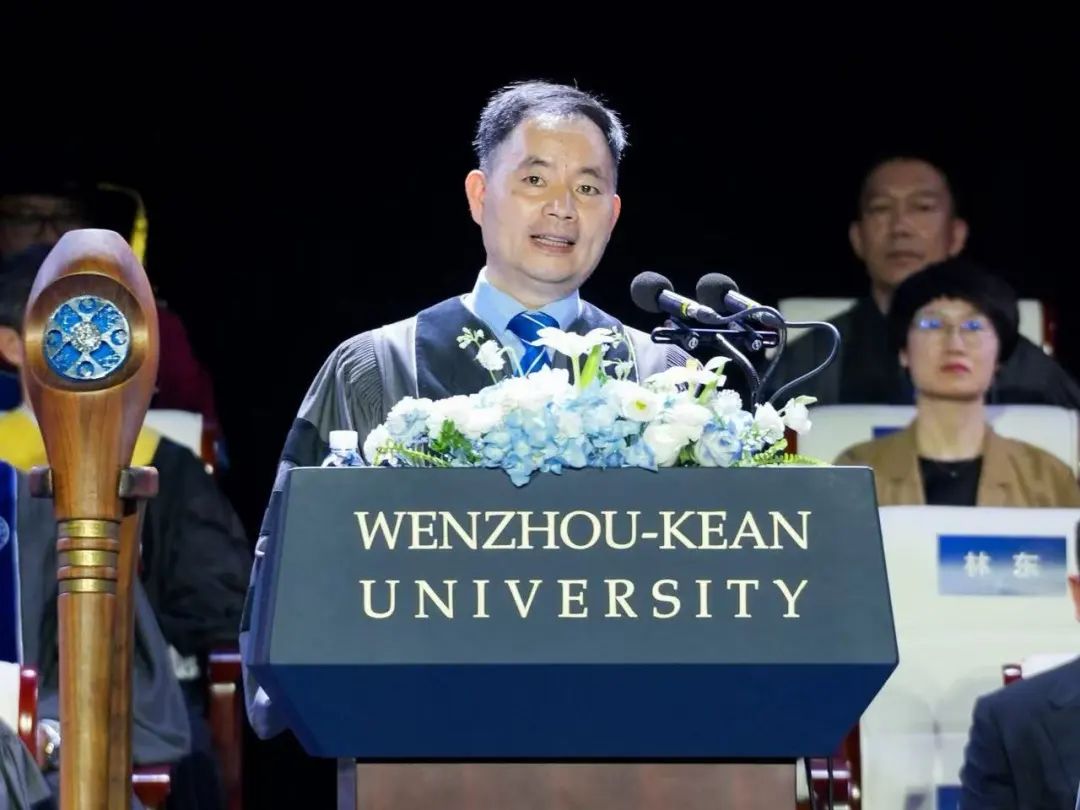Speech by Mr. Lin Dong
Speech by Mr. Lin Dong, Standing Committee Member of both the All-China Federation of Returned Overseas Chinese and the Zhejiang Provincial Committee of the CPPCC, and Vice President of the Zhejiang Western Returned Scholars Association
Dear leaders, faculty, and students,
Good afternoon!
I am Lin Dong, Director of Zhejiang LHD Ocean Tidal Current Energy Engineering Research Center and Chairman of Hangzhou Greenful Group. Thank you, Wenzhou-Kean University, for inviting me to attend the 2025 Commencement Ceremony. Today, I would like to share with you the theme: Be an Entrepreneur with the Spirit of a Scientist. I will recount how I led Greenful Group, originally a beef jerky enterprise, took a leap to develop and build the world’s first ocean tidal current energy power station, along with experiences and insights gained during this journey.
I also wish to extend my warmest congratulations to the graduating students of Wenzhou-Kean University!
In 2001, I returned from studying in Australia and founded Hangzhou Greenful Food Group. In 2008, the company was awarded the title of “Major Taxpayer among Foreign-Invested Enterprises” by the Hangzhou Municipal Government.
In 2009, the Hangzhou University Student Entrepreneurship Alliance was established, and I served as its first Chairman. Around the same time, the Hangzhou Municipal Government proposed that qualified enterprises should move their technology research and development incubators to developed countries. I began to think: My life shouldn’t be limited to making beef jerky; I should also pursue high-tech breakthroughs. In April 2009, I co-founded LHD Technology Inc. in the United States with two doctors from the University of Southern California, specializing in marine energy research. “LHD” is derived from the initials of the Chinese surnames of the three founders: Lin, Huang, and Ding.
In 2012, the LHD team returned to Qiandao Lake, Hangzhou, to continue our research and development. During the project’s development, we received two written approvals and on-site guidance from Li Qiang, then Governor of Zhejiang Province (now Premier of the State Council). He even shared with us an approval document on marine energy issued by President Xi during his tenure in Zhejiang, which greatly inspired the LHD team.
As early as October 6, 2005, when President Xi served in Zhejiang, he made a forward-looking instruction, “The development and utilization of tidal energy align with the development direction, and our province has superior conditions for its development. Although it cannot become a primary energy source for now, we should promote its development from this moment to lead the country in this field.”
Guided by President Xi’s instructions and with strong support from all sectors of society, in August 2016, China’s first-generation 1 MW tidal current energy power station unit was successfully connected to the national grid in Zhoushan. After three iterations, in April 2022, the world’s largest single-unit LHD fourth-generation 1.6 MW “Fen Jin Hao” unit was connected to the grid.
The levelized cost of energy (LCOE) for tidal current energy has dropped from 106 yuan/kWh for the first generation to 1 yuan/kWh for the fourth generation (at scale). It is expected that by the seventh generation, the LCOE could reach 0.3 yuan/kWh, lower than thermal power, delivering affordable ocean clean energy to people through original Chinese research and development.
As of early June, the LHD power station has an installed capacity of 1.9 MW, with over 8 years of continuous grid operation and a cumulative power supply of over 8.3 million kWh, maintaining the global lead in both single-unit scale and operational duration.
By comparison, the U.S. GE, UK Rolls-Royce, and France Alstom jointly developed a 1 MW unit over 12 years, with a total cumulative power supply of 1.2 million kWh during its lifecycle and a maximum continuous grid operation of 113 days. In August 2018, GE abandoned tidal current turbine research and development, laying off staff to other renewable energy divisions. France’s DCNS (manufacturer of the Charles de Gaulle aircraft carrier) saw its 1 MW tidal energy project fail in July 2018, with its subsidiary declaring bankruptcy and debts approaching 2.2 billion RMB. Japan’s 0.1 MW unit, developed by the Ministry of Economy, Trade and Industry and IHI Corporation, still can’t provide continuous grid-connected power generation.
On September 16, 2024, the International Energy Agency’s Ocean Energy Systems (IEA-OES) released the Global Top 20 Marine Energy Highlights at its 50th Executive Committee meeting in Melbourne. The LHD power station, as China’s sole selected project, ranked first in tidal current energy and was recognized by the IEA as the world’s only operational tidal current energy power station.
The International Energy Agency OES also projected ahead of the 28th UN Climate Change Conference that global marine energy installed capacity will reach 300 gigawatts by 2050, with equipment demand exceeding 4 trillion RMB. This presents a significant target market for China’s tidal current energy high-end equipment to “go global”.
The success of the LHD project has brought numerous honors: In October 2018, National Geographic filmed a 5-minute documentary at the Zhoushan power station, broadcast globally. Just before the 19th National Congress of the Communist Party of China, the LHD project was exhibited at the “Five Years of Forging Ahead” grand achievement exhibition in Beijing. On June 13, 2019, I delivered a 7-minute interactive report to the late Premier Li Keqiang, who now we can only pay our condolences to. In August 2019, China’s first tidal current energy pricing was approved, allowing us to officially charge for generated power. In September 2022, the project won the FIDIC Engineering Award in Geneva. In December 2022, it was listed as one of China’s Top 10 Science and Technology News, ranked fourth alongside the National Space Laboratory. In February 2023, we obtained China’s first tidal current energy green certificate from the National Energy Administration. In December 2024, the LHD tidal current energy unit was recognized as a Zhejiang International First Set. The highest honor, in my view, is that our research and development story was adapted into the 35-episode TV series Melody of Forging Ahead, a tribute to the 70th anniversary of the People’s Republic of China, broadcast during prime time on the National Television CCTV-1. I encourage you to watch it online!

Class of 2025, looking at your youthful faces today, I feel both admiration and heartfelt joy. At this important milestone in your lives, I see not only the excitement of graduation in your eyes, but also sparkles with the eagerness to explore the future.
On this special occasion, I’d like to share a reflection close to my heart: Entrepreneurs with the spirit of scientists, and scientists with an entrepreneurial mindset, are the driving force behind technological advancement. For thousands of years, Chinese culture has honored the belief that “those who excel in learning should enter government service”. Yet among the people of Wenzhou, the entrepreneurial spirit runs deep. I want to tell you this: becoming an entrepreneur is a noble and meaningful pursuit. I’ll give three examples each of scientists and entrepreneurs.
First, three scientists who embodied the entrepreneurial spirit: Thomas Edison was not only an inventor and scientist, but also a visionary entrepreneur. He founded the Edison Electric Light Company and reduced the cost of electric lighting from $ 25 to just 5 cents, making it affordable for everyday use and helping to illuminate the modern world. Alexander Bell, the inventor of the telephone, went on to establish the Bell Telephone Company, which later evolved into AT&T, one of the largest telecommunications providers in the United States. One of its greatest legacies is Bell Labs, which produced 11 Nobel Laurates and invented the transistor in 1947, ushing in the Information Age. Alfred Nobel, though known as a scientist, achieved lasting impact through his entrepreneurial foresight. His establishment of the Nobel Prizes continues to inspire generations of scientists to push boundaries of science and technology.
Now, let’s look entrepreneurs who embody the scientific spirit. Internationally, we have Elon Musk, Bill Gates, and Jensen Huang. In China, we have Ren Zhengfei, founder of Huawei; Zhang Yiming, founder of ByteDance and TikTok; Frank Wang, founder of DJI; and Liang Wenfeng, founder of DeepSeek. These pioneers are powerful forces driving human and social progress.
In today’s world, many areas of development are approaching their limits, whether it’s environmental sustainability, population growth, career advancement, or job markets. But innovation and entrepreneurship know no ceiling. Thanks to the rise of modern corporate and securities systems, each of us has the potential to become a transformational force and help propel humanity forward. From the journeys of Elon Musk, Jensen Huang, and Liang Wenfeng, we see how individuals can grow into key players in global competition.
The United States remains a powerhouse of scientific and technological innovation, while Wenzhou has emerged as a new hub of entrepreneurship in China. I sincerely hope that Wenzhou-Kean University will nurture more world-class entrepreneurs, thereby contributing to human progress and serving as a new model of integrated development between China and the United States.
Thank you.




